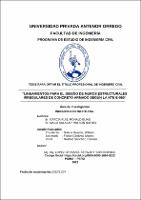Mostrar el registro sencillo del ítem
Lineamientos para el diseño de muros estructurales irregulares de concreto armado según la NTE E -060
| dc.contributor.advisor | Lopez Otiniano, Stewart Yaroshenko | |
| dc.contributor.author | Garcia Ruiz, Ronald Elias | |
| dc.contributor.author | Maco Salazar, Wilson Rafael | |
| dc.creator | Garcia Ruiz, Ronald Elias | |
| dc.date.accessioned | 2022-12-27T17:29:04Z | |
| dc.date.available | 2022-12-27T17:29:04Z | |
| dc.date.issued | 2022 | |
| dc.identifier.uri | https://hdl.handle.net/20.500.12759/9910 | |
| dc.description.abstract | El presente informe de tesis fue una investigación de tipo exploratoria, donde se realizó el estudio de 3 muros de concreto armado: un muro regular, un muro irregular tipo L y uno muro irregular tipo C, analizando 3 viviendas multifamiliares, que oscilan entre los entre los 6 y 9 niveles, diseñando cada uno de los elementos que forman los muros estudiados, con el objetivo de obtener criterios y lineamientos mínimos para el diseño de muros irregulares de concreto armado. Para ello, se usó el programa estructural de edificaciones Etabs 2019, con el cual modelamos las estructuras y verificamos que los resultados del análisis estructural, sísmico estático, sísmico dinámico y modal, cumplan con lo establecido en nuestro RNE, verificando que la relación Demanda – Capacidad fue menor a 1 en cada muro a Flexocompresión y por Cortante - Capacidad. Adicionalmente a esto, se diseñó los elementos de borde, puesto que su correcto confinamiento, otorgó mayor ductilidad al muro. También usamos el programa Sap 2000 para hallar la profundidad de compresión de la fibra más traccionada al eje neutro, haciendo una comparación de este resultado con el que nos ofrece el método simplificado que propuso años atrás el Dr Jack Moehle. Esta comparación tuvo un asertividad del 80% entre estas dos metodologías. Después detallamos el armado del acero de refuerzo de cada muro, e hicimos una comparativa entre la distribución de acero de refuerzo según nuestra normar NTE E.060 y el ACI 318.14, donde se verificó que actualmente no contamos con una adecuada norma para confinar los bordes de los muros de concreto armado. Finalmente propusimos los pasos a seguir para el correcto análisis, diseño y armado de los muros estructurales estudiados, dentro de los cuales concluimos que se debe confinar los elementos de borde con el Código ACI 318, hasta que nuestra norma E.060 tenga una correcta actualización. | es_PE |
| dc.description.abstract | The present thesis report was an exploratory research, carried out the study of 3 reinforced concrete walls: a regular wall, an irregular wall type L and an irregular wall type C, analyzing 3 multi-family dwellings, which range between 6 and 9 levels, designing each one of the elements that form the walls studied, with the aim of obtaining criteria and minimum guidelines for their design For this, the Etabs 2019 building structural program was used, with which we modeled the structures and verified that the results of the structural, static seismic, dynamic seismic and modal analysis, comply with what is established in our RNE, verifying that the Demand - Capacity was less than 1 in each wall at Flexocompression and Shear - Capacity. In addition to this, the edge elements were opened, since their correct confinement gave the wall greater ductility. We use the Sap 2000 program to find the compression depth of the fiber with the most traction to the neutral axis, comparing this result with the one offered by the simplified method, which ten years ago Dr Jack Moehle, this comparison had an assertiveness of 80% between these two methodologies. Then we detailed the reinforcing steel reinforcement of each wall, and made a comparison between the distribution of reinforcing steel according to our NTE E.060 standard and ACI 318.14, where it was verified that we currently do not have an adequate standard to confine the edges. of reinforced concrete walls. Finally, we proposed the steps to follow for the correct analysis, design and assembly of the structural walls studied, within which we concluded that the edge elements must be confined with the ACI 318 Code, until our E.060 standard has a correct update | en_US |
| dc.description.uri | Tesis | es_PE |
| dc.format | application/pdf | es_PE |
| dc.language.iso | spa | es_PE |
| dc.publisher | Universidad Privada Antenor Orrego | es_PE |
| dc.relation.ispartofseries | T_CIVILP_034 | |
| dc.rights | info:eu-repo/semantics/openAccess | es_PE |
| dc.rights.uri | https://creativecommons.org/licenses/by/4.0/ | es_PE |
| dc.source | Universidad Privada Antenor Orrego | es_PE |
| dc.source | Repositorio Institucional - UPAO | es_PE |
| dc.subject | NTE E 060 | es_PE |
| dc.subject | Muros Estructurales | es_PE |
| dc.title | Lineamientos para el diseño de muros estructurales irregulares de concreto armado según la NTE E -060 | es_PE |
| dc.type | info:eu-repo/semantics/bachelorThesis | es_PE |
| thesis.degree.level | Título Profesional | es_PE |
| thesis.degree.grantor | Universidad Privada Antenor Orrego. Facultad de Ingeniería | es_PE |
| thesis.degree.name | Ingeniero Civil | es_PE |
| thesis.degree.discipline | Ingeniería Civil | es_PE |
| dc.subject.ocde | https://purl.org/pe-repo/ocde/ford#2.01.00 | es_PE |
| renati.advisor.orcid | https://orcid.org/0000-0003-1694-5212 | es_PE |
| renati.author.dni | 47249019 | |
| renati.author.dni | 48259798 | |
| renati.advisor.dni | 71802352 | |
| renati.type | https://purl.org/pe-repo/renati/type#tesis | es_PE |
| renati.level | https://purl.org/pe-repo/renati/level#tituloProfesional | es_PE |
| renati.discipline | 732016 | es_PE |
| renati.juror | Galicia Guarniz, William. | |
| renati.juror | Farfán Córdova, Marlon | |
| renati.juror | Geldres Sánchez, Carmen | |
| dc.publisher.country | PE | es_PE |
Ficheros en el ítem
Este ítem aparece en la(s) siguiente(s) colección(es)
-
Ingeniería Civil [1260]


